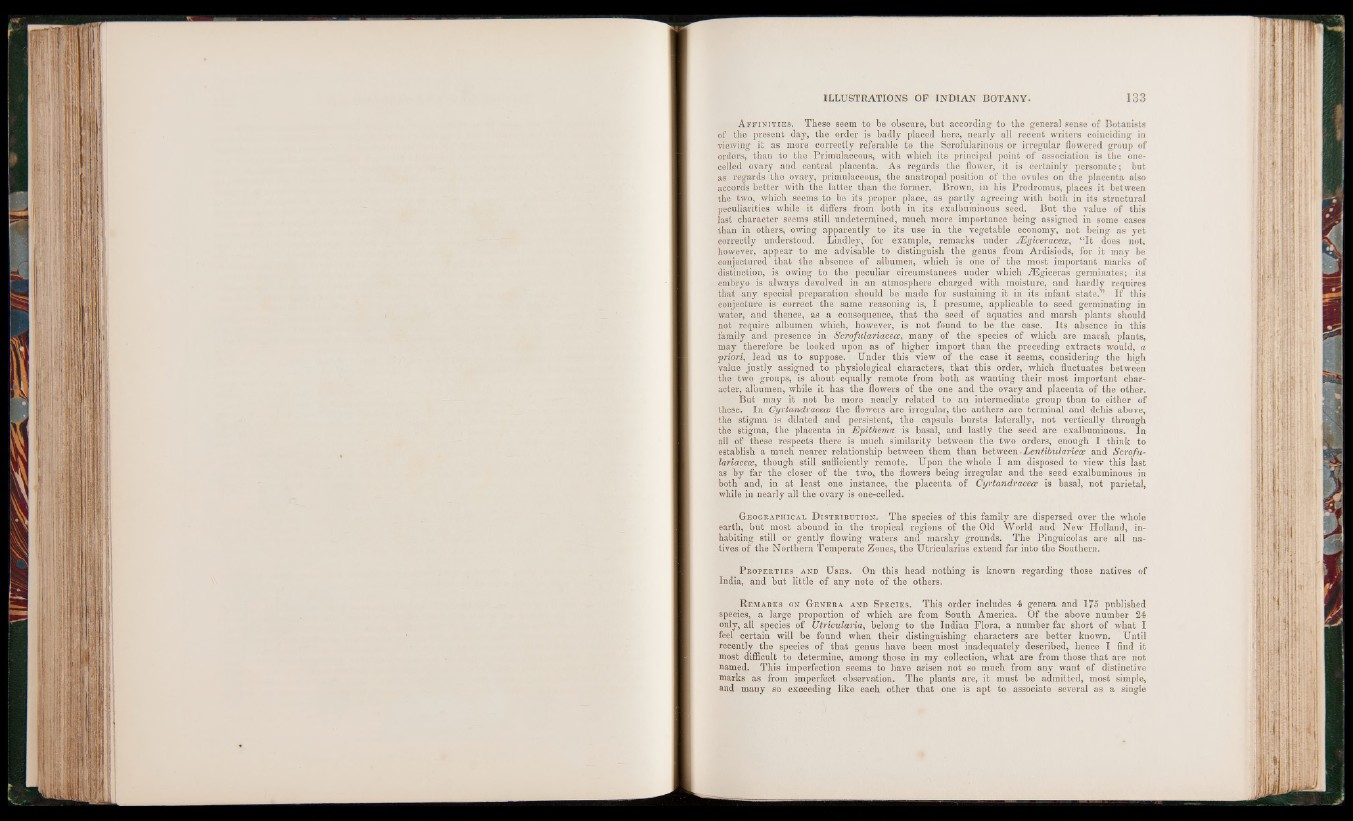
Af f in it ie s . These seem to be obscure, but according to the genera] sense of Botanists
of the present day, the order is badly placed here, nearly all recent writers coinciding in
viewing it as more correctly referable to the Scrofularinous or irregular flowered group of
orders, than to the Primulaceous, with which its principal point of association is the one-
celled ovary and central placenta. As regards the flower, it is certainly personate; but
as regards the ovary, primulaceous, the anatropal position of the ovules on the placenta also
accords better with the latter than the former. Brown, in his Prodromus, places it between
the two, which seems to be its proper place, as partly agreeing with both in its structural
peculiarities while it differs from both in its exalbuminous seed. But the value of this
last character seems still undetermined, much more importance being assigned in some cases
than in others, owing apparently to its use in the vegetable economy, not being as yet
correctly understood. Lindley, for example, remarks under JEgiceracece, “It does not,
however, appear to me advisable to distinguish the genus from Ardisiods, for it may be
conjectured that the absence of albumen, which is one of the most important marks of
distinction, is owing to the peculiar circumstances under which ^Egiceras germinates; its
embryo is always devolved in an atmosphere charged with moisture, and hardly requires
that any special preparation should be made for sustaining it in its infant state.” If this,
conjecture is correct the same reasoning is, I presume, applicable to seed germinating in
water, and thence, as a consequence, that the seed of aquatics and marsh plants should
not require albumen which, however, is not found to be the case. Its absence in this
family and presence in Scrofulariaceas, many of the species of which are marsh plants,
may therefore be looked upon as of higher import than the preceding extracts would, a
priori, lead us to suppose, i Under this view of the case it seems, considering the high
value justly assigned to physiological characters, that this order, which fluctuates between
the two groups, is about equally remote from both as wanting their most important character,
albumen, while it has the flowers of the one and the ovary and placenta of the other.
But may it not be more nearly related to an intermediate group than to either of
these. In Cyrtandraceos the flowers are irregular, the anthers are terminal and dehis above,
the stigma is dilated and persistent, the capsule bursts laterally, not vertically through
the stigma, the placenta in Epithema is basal, and lastly the seed are exalbuminous. In
all of these respects there is much similarity between the two orders, enough I think to
establish a much nearer relationship between them than between r Lentibularieoe and Scrofu-
lariacece, though still sufficiently remote. Upon the whole I am disposed to view this last
as by far the closer of the two, the flowers being irregular and the seed exalbuminous in
both and, in at least one instance, the placenta of Cyrtandracece is basal, not parietal,
while in nearly all the ovary is one-celled.
Geographical D istribution. The species of this family are dispersed over the whole
earth, but most abound in the tropical regions of the Old World and New Holland, inhabiting
still or gently flowing' waters and marshy grounds. The Pinguicolas are all natives
of the Northern Temperate Zones, the Utricularias extend far into the Southern.
P roperties and U ses. On this head nothing is known regarding those natives of
India, and but little of any note of the others.
R emarks on Genera and Species. This order includes 4 genera and 175 published
species, a large proportion of which are from South America. Of the above number 24
only, all species of Utricularia, belong to the Indian Flora, a number far short of what I
feel certain will be found when their distinguishing characters are better known. Until
recently the species of that genus have been most inadequately described, hence I find it
most difficult to determine, among those in my collection, what are from those that are not
named. This imperfection seems to have arisen not so much from any want of distinctive
marks as from imperfect observation. The plants are, it must be admitted, most simple,
and many so exceeding like each other that one is apt to associate several as a single